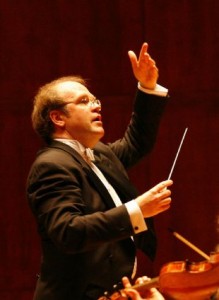UTAH SYMPHONY AND CHORUS, Abravanel Hall, April 27; second performance 8 p.m. April 28, tickets at 801-355-2787 or 888-451-2787 or www.utahsymphony.org
Wolfgang Amadeus Mozart’s Requiem has been on Utah Symphony programs frequently but never played as well as it was Friday night under the baton of guest conductor Bernard Labadie. One of today’s preeminent interpreters of 18th century music, Labadie has performed the Requiem often and has also recorded it with his ensembles Les Violons du Roy and La Chapelle de Québec. In fact he knows the work so intimately he conducted it Friday without the aid of a score.
Labadie uses American musicologist and pianist Robert Levin’s completion of the Requiem, which was premiered two decades ago by Helmuth Rilling in Stuttgart, Germany. For Labadie this version more accurately realizes Mozart’s intentions with the work, and, in fact, it has structural and thematic integrity and a musical cohesiveness that the more widely known version by Franz Xaver Süssmayr lacks.
Labadie presented his audience a wonderfully vibrant and dramatic account of Mozart’s final work. He brought passion and strong emotions to his interpretation but also finely crafted lyricism. In the “Dies irae” and “Rex tremendae” sections, Labadie’s brisk tempos underscored the urgency of the dark and somber texts, while the “Lacrimosa” was heartbreakingly tender. Throughout the work Labadie never failed to bring out the meaning of the words in the music.
The downsized orchestra played magnificently. Labadie asked for and certainly got clean, crisp and well articulated playing with beautifully shaped phrasings and rich expressiveness.
The Utah Symphony Chorus sang with conviction and clarity. As with the orchestra, the singers responded to Labadie’s direction wonderfully and conveyed the nuances of their music effortlessly.
The four soloists (soprano Shannon Mercer; mezzo-soprano Anita Krause; tenor Colin Balzer; baritone Tyler Duncan) were situated on a riser behind the first violins. This placement worked surprisingly well, and their well matched voices brought expressiveness and feeling to their parts.
The concert opened with a delightful account of the Chaconne from Mozart’s ballet music for his opera seria Idomeneo, followed by Joseph Haydn’s Symphony No. 101 in D major (The Clock).
One of Haydn’s sunniest works, the D major Symphony was given a radiant reading, thanks in part to Labadie’s brisk tempos. The musicians played crisply and precisely, and Labadie’s probing perusal missed nothing in the way of subtleties. This was glorious Haydn and showed that the Utah Symphony is more than up to the challenges of 18th century music when led by an expert conductor. Hopefully, Labadie will return to Abravanel Hall to lead the symphony on many more occasions in the future.

